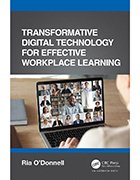How to approach learning technologies in the workplace
Author Ria O'Donnell discusses the importance of continuing professional development and how to approach digital learning technologies in the workplace, including VR and AI.
The COVID-19 pandemic drove many organizations to modernize their operations, whether it was to deploy AI to automate processes or replace legacy tools with cloud-based services. These workplace changes also meant employees needed to learn new skills. It's increasingly important for organizations to provide workplace learning and professional development to teach new skills and retain employees.
In the book Transformative Digital Technology for Effective Workplace Learning, author Ria O'Donnell provides a deep dive into how workplace learning has evolved due to factors including the pandemic, the rise of the gig economy and emerging technologies. She also provides insights into how organizations can use digital technologies to teach employees new skills and measure the effectiveness of workplace learning.
In this interview, O'Donnell discussed how organizations can approach integrating digital learning technologies in the workplace and address the challenges organizations face when implementing new learning technology.
Editor's note: This interview has been edited for length and clarity.
The COVID-19 pandemic accelerated many industries by five to 10 years. Have you seen that effect in how people learn and how organizations facilitate professional development?
Ria O'Donnell: 100% because people need to learn new roles and new ways of working because they're decentralized and are having to take on responsibilities they didn't need to take on before. Some people are thrown in front of computers that may not necessarily have used computers, and they are thrown into having to learn new things.
At the same time, they have to learn it in a way they may not have been familiar with by using technology. They may have historically been at the workplace and have done a classroom session where they have an instructor teaching them the new skills, whereas now everyone's just been thrown into the deep end, and they need to learn how to learn using technology on top of new skills.
For businesses evaluating new learning technologies in the workplace, such as augmented reality (AR) and virtual reality (VR), AI and experience APIs, how do you recommend they determine which is the best option for their employees?
 Ria O'Donnell
Ria O'Donnell
O'Donnell: I think it's probably worth a lot of businesses outsourcing professionals or bringing in in-house professionals, where in their role they're able to assess the whole landscape. They're able to look at the whole learning and development framework across the organization and say, 'These are the things staff or contingent workers require; these are the tools that would help them; these are the resources we have.'
They can do it like an audit of everything organizations have and the skill gaps they need to close. They can make recommendations of whether the organization needs to invest in AR and VR or in AI. They can also look at the type of learning analytics in place and the next steps to look at the personalization of learning and giving opportunities to people who might be a little bit above or a little bit below the mainstream as well.
One challenge discussed in your book is the lack of standards for implementing and measuring the effectiveness of newer technologies, like AR and VR. How can organizations make newer technologies work for their workplace learning initiatives?
O'Donnell: When you look at it from a smaller point of view and you're looking at a single organization, if they are to develop what they think is their own framework and their own standards, what would they need to be able to benchmark where people are? They can map out what they need and what pathway they want to see people on. They can come up with mini standards of their own and be able to benchmark against them while waiting for the rest of the technology to catch up.
Some employees might resist using technology, like a VR headset, in a learning scenario. How can organizations incorporate new technology in a way that encourages employees to use them?
O'Donnell: It's a two-pronged issue because you're teaching people new skills but you're also teaching them how to learn those skills. When you're teaching someone, how do you use a VR headset and interact with that type of technology, which is a steep learning curve? To try and involve people is a cultural shift to where it becomes part of what they do every day.
It doesn't become something that's separate, where you go away to take a course, and it's like a once-a-year opportunity. It becomes something that people are doing day in and day out, and they share their new knowledge with others, and everything is integrated to their key performance indicators or their team goals. It becomes part of the daily routine to have that expectation of ongoing learning and development.
How else do you see learning technologies in the workplace advancing?
O'Donnell: There is opportunity for startups and businesses in the educational technology space because this is something that's taking over -- quite literally -- the whole world where everyone needs to learn. It used to be limited to schooling, and now, everyone needs ongoing learning.
These educational technology startups have a huge opportunity just in the way there are reduced barriers to entry now because there's a lot of sharing. Everything's in the cloud. People are able to test things, and there are a lot of organizations willing to be tested. There's a lot of investment in that space as well. It's just a huge marketplace that really needs some technologies to fill the gaps. For people looking at developing virtual reality simulations or AI capabilities, they really do have a huge opportunity.
What is the key takeaway for readers of your book?
O'Donnell: I think the key takeaway for this book is the way technology is advancing at such an accelerated pace that things are never going to slow down or go backwards. We all need to make the effort to try new digital technologies and to engage and immerse ourselves in those technologies rather than falling back to old, comfortable ways. Because, as we've seen, what's happened with the pandemic and the way the workplace has changed, with people working from home, we'll never go back to that same normal we had before.








